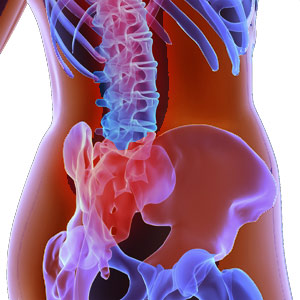Groin Hernia in Woman

A lump (protrusion) in the groin could cause moments of anxiousness in any person. Groin hernia is a protrusion of an organ or tissue through a weak spot in a muscle in the groin area. As the hernia enlarges, a sac is formed and the internal organs (like intestine) fall into the sac thus producing a bulge. This bulge is prominent when the person is standing and goes in while the person is lying down. Groin hernia is also referred to as inguinal hernia. (inguinal refers to groin in Latin)
Why does hernia occur in the groin?
- Occurrence of hernia in the groin region is very common because of the natural anatomical weakness of the groin region. The groin region is weak as it does not have complete muscle coverage.
- All humans stand in an upright position, this posture exerts a greater force pushing towards the bottom of the abdomen. This in turn increases stress on the weaker tissues thereby causing hernia.
Types of groin hernia
Inguinal hernia: This is a type of groin hernia that is caused by a weak spot in the groin area. It is more common in men than in women. In men inguinal hernia develops in the region where the spermatic chord and blood vessels to the testicles pass out of the abdominal cavity into the scrotum. This area is termed as the inguinal canal.
In women inguinal hernia develops in the region where the connective tissue connecting the uterus exits from the abdomen to join with the tissue surrounding the vaginal opening.
Femoral hernia: This is a type of abdominal hernia where a lump is found in the upper thigh. This type of hernia is very common in women. This hernia is often associated with inguinal hernia as the bulge occurs just below the groin crease.
Types of inguinal hernia
Direct hernia: Affects both men and women. The intestine forms a loop in the inner parts of the groin thus making it to bulge. Direct inguinal hernia appears in later life.
- Hernia occurs on both the sides.
- This type of hernia can be felt and seen in the middle of the inguinal ligament.
- Hard physical work can cause groin hernia.
- Surgery is the usual treatment for this type of hernia. Somehow, in a few cases hernia might reoccur and surgery has to be repeated.
- If the hernia does not cause any further complications, doctors might not recommend a surgery.
Indirect hernia: Affects men only. A loop of intestine passes down the inguinal canal from where the testis descends into the scrotum.
- Indirect inguinal hernia usually occurs in the inguinal canal. In men, the hernia occurs in the spermatic cord.
- This type of hernia is identified when it descends into the scrotum.
- This type of hernia could be congenital.
- Common treatment for this kind of hernia is surgery. If the condition is congenital, surgery is performed after the child is two.
Incisional hernia: The protrusion of tissue through an incision is known as Incisional hernia. It may be the result of the stress on the stitches upon an incision in vulnerable obese patients. This type of hernia can be addressed by resuturing the incision.
Femoral hernia: Femoral hernias are very rare but occur mostly in women. These hernias appear right below the groin crease. These hernias occur as a result of pregnancy and childbirth. The intestinal sac slips into the femoral area through a weak area in the lower groin. These hernias develop incarceration or strangulation very early when compared to inguinal hernias. These hernias, once diagnosed should be repaired as early as possible (this hernia is associated with inguinal/groin hernia as the bulge develops at the groin crease).
Apart from the above inguinal hernia can also be classified into the below mentioned types
Strangulated hernia: The intestine becomes twisted or swollen and hampers the normal blood flow and muscle action. Immediate surgery is needed in this type of hernia.
Reducible hernia: In a reducible hernia the protrusion can be pushed back to place.
Incarcerated hernia: The protrusion in an incarcerated hernia can't be put back into place without surgery.
Who develops groin hernia?
Groin hernia is common in:
- Premature infants
- Aging adults
- Pregnant women
- People who do not exercise and are overweight
Cause for groin hernia
There is no obvious cause for hernia. Hernia might occur if a person:
- Lifts heavy weights
- Incurs damage to the groin
- Has birth defect
- Has premature tissues
Other common causes for hernia include:
- Chronic cough
- Cystic fibrosis
- Chronic constipation/strained bowel movements
Groin hernia symptoms
- Localized swelling
- Protrusion in the groin area, protrusion will be prominent when the person is urinating, passing bowels, or while lifting heavy objects.
- Few people experience a feeling of fullness or heaviness in the area of the lump.
- Few people experience discomfort and pain, the discomfort grows while the person is standing for too long, straining too much or while lifting heavy objects.
- Generally the lump is big when standing and it sinks in when the person is lying down.
- A lump can be pushed back with the finger.
In a few people with severe hernia, symptoms might include:
- Fever
- Fast heartbeat
- Nausea/vomiting
Groin hernia diagnosis
The doctor will perform a physical examination to check for a bulge. Other tests may include a CAT scan of the abdomen to study the hernia thoroughly. Normally in women, a pelvic examination is done using a speculum and a Papanicolaou
test (Pap test) would help in diagnosis. The doctor might want additional information:
- When did you notice the lump?
- Has it become bigger from when it appeared?
- After the growth has it always remained there?
- Does the lump go in while you push it or while you cough?
- Have you been physically overactive?
Prevention of groin hernia
Development of hernia is not under the control of individuals. A few people inherit and yet a few develop
hernia as they grow old. Conscious prevention can include:
- Avoid lifting heavy objects
- Follow good body mechanics
- Maintain optimum weight, if overweight, lose weight
- Exercise regularly
- Warm up before exercising
- Prevent constipation by consuming plenty of fiber
- Stop smoking, in particular if you have cough
Groin hernia treatment
- The most common and effective treatment for groin hernia is surgery. Surgical technique depends on the herniated tissue. Herniorrhaphy (Surgical correction of a hernia) - Surgery is usually the most effective cure where the affected protruding tissue can be repaired using stitches. But for larger hernias or for a recurring hernia, synthetic meshes are used as patches to repair in a surgical procedure known as Hernioplasty.
- Hernia in adults needs to be operated only if the hernia is causing discomfort or if it carries the risk of strangulation.
- Direct inguinal hernias that are small and are not causing any discomfort do not require surgery.
- All femoral and indirect inguinal hernias have to be operated on if the patient is fit for surgery.
Groin hernia surgery
Groin hernia is usually repaired through a surgery. In few cases where the hernia does not interfere with the day to day activities of the patient, surgery is not recommended. Groin hernia surgery can be classified into two types:
Open hernia repair surgery: an incision is made in the groin and the hernia is repaired.
Laparoscopic hernia repair: this is mainly used in adults. The necessary repair work is carried over by making an incision with the help of a thin, lighted scope introduced in to the abdomen.
Groin hernia repair
- Groin hernia surgery is performed under general anesthesia. In few cases local anesthesia or spinal anesthesia are also used.
- Surgeries for groin hernia can be performed as an outpatient service; patients with complications might have to stay overnight.
- Post surgery, the patient can get back to normal activities within a couple of weeks.
- Recurrence of hernia after it has been surgically removed is very remote (less than 1%).
- Keyhole surgery options are also available. Post-surgery the patient can get back to normal activity.
Non-surgical treatment for groin hernia
Truss: The bulge is pushed into place manually by the physician; he then recommends a belt to be worn around the area. This belt is called a truss and is used to hold the hernia back in its place. The truss also helps in easing the discomfort caused by direct and indirect inguinal hernia. A truss is useful for patients who are waiting to get fit for surgery.
Top of the Page: Groin Hernia in Woman
Tags:#groin hernia women #groin hernia symptoms #groin hernia surgery #groin hernia repair
Causes of Stomach Ulcers
Abdominal Hernia
Internal Body Cleansing
Ulcerative Colitis
Irritable Bowel Syndrome
Acid Reflux Syndrome
Belly Bloat
Inflammatory Bowel Disease
Groin Hernia in Woman
Carcinoid
Colonoscopy Procedure
Bariatric Surgery
Hemorrhoids
Colon Cleansing
Other health topics in TargetWoman Women Health section:
General Women Health

Women Health Tips - Women Health - key to understanding your health ...
Cardiac Care
Women's Heart Attack Symptoms - Identify heart problems...
Skin Diseases
Stress Hives - Red itchy spots ...
Women Disorders
Endocrine Disorder - Play a key role in overall wellbeing ...
Women's Reproductive Health
Testosterone Cream for Women - Hormone replacement option ...
Pregnancy
Pregnancy - Regulate your lifestyle to accommodate the needs of pregnancy ...
Head and Face
Sinus Infection - Nearly 1 of every 7 Americans suffer from ....
Women and Bone Care

Slipped Disc - Prevent injury, reduce pain ...
Menstrual Disorders
Enlarged Uterus - Uterus larger than normal size ...
Female Urinary Problems
Bladder Problems in Women - Treatable and curable ...
Gastrointestinal Disorders
Causes of Stomach Ulcers - Burning feeling in the gut ...
Respiratory Disorders
Lung function Test - How well do you breathe ...
Sleep Management

Insomnia and Weight Gain - Sleep it off ...
Psychological Disorders in Women
Mood swings and women - Not going crazy ...
Supplements for Women
Women's Vitamins - Wellness needs...
Natural Remedies

Natural Diuretic - Flush out toxins ...
Alternative Therapy
Acupuncture Point - Feel the pins and needles ...
Top of the Page: Groin Hernia in Woman
Popularity Index: 101,702

